Features Editor
Planning, Flexibility Key in Electric Fleet Management

[Stay on top of transportation news: Get TTNews in your inbox.]
CLEVELAND — Experts stressed common considerations in electric fleet management in a study group session during American Trucking Associations’ 2021 Technology & Maintenance Council Fall Meeting & Transportation Technology Exhibition.
Ray Hasting, director of e-mobility and national vocational accounts for Volvo and Mack trucks, offered an OEM perspective by explaining the rationale for electromobility. He contended that with electric fleet units, labor is considerably reduced while scheduled maintenance items such as oil and engine filter changes would be deemed nonexistent.
Hasting also said that fleet electrification would drastically impact overall part volumes such as powertrain and brakes.

“You have to make sure your equipment arrives on time. As with everything in shipping, delays can happen,” says Penske Transportation Solutions' Sean Yentsch. (John Sommers II for Transport Topics)
“If you have a good driver who uses regenerative braking, you should see very little brake wear,” he said, adding that where some diesel tech shops would complete brake repairs every five weeks, an electric vehicle wouldn’t need a brake repair for perhaps years.
Hasting described Volvo’s battery-electric vehicle certification process in which staff are trained for safety and clear areas of work bay identification, signage and barricades. Its safety department adheres to a protocol of proper charging infrastructure standards such as PPE requirements and identifying quarantine areas for ‘RED’ or damaged batteries, with its parts department keeping adequate records of commonly used parts and storage for traction batteries.
Sean Yentsch, vice president of facilities for Penske Transportation Solutions, said that fleet planning demands flexibility, especially when managers are bombarded with a vast amount of options.
“You know your fleet. [Consider facts such as] when does [the EV] leave the site? When does it come back? How much load time does it have? All of that is a fixed entity in time,” he said, stressing that it’s important to ask OEMs’ vendors for the proper advice when planning an electric fleet concerning charging times and routes.
Another point Yentsch noted was that timing is everything in site planning.
“You need to think about your chargers because if you order your truck tomorrow, the truck is going to be here before your chargers,” he said. “You have to make sure your equipment arrives on time. As with everything in shipping, delays can happen.”
Factoring considerations such as leasing versus buying, charging stations and kilowatt power, Yentsch said, play a major role in taking on an electric fleet. However, he told attendees that partnerships are available that offer utility services, design help and grant programs as well as networking and basic service.
“As the heavy-duty and the light-duty truck industry matures,” he said, “be patient, ask questions and don’t be afraid to fail because we are all in this thing together.”
Want more news? Listen to today's daily briefing below or go here for more info:





